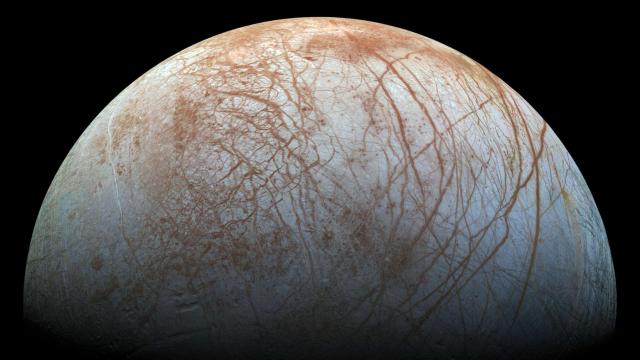The icy surface of Jupiter’s moon Europa appears to be continually feeding its thin atmosphere with water vapour, according to Hubble observations made from 1999 to 2015.
New research published in Geophysical Research Letters describes a stable water atmosphere on Europa. Strangely, this apparent water vapour was only detected on the moon’s tailing hemisphere, that is, the side that faces away from its orbital direction. Astronomer Lorenz Roth from KTH Royal Institute of Technology in Sweden is the paper’s lone author.
Europa features a vast global ocean that’s completely covered in a layer of ice. Water plumes are known to erupt from cracks on the surface, shooting vapour more than 60 miles (100 kilometers) high. This results in scattered, transient pockets of water vapour in Europa’s achingly thin atmosphere.
But the water vapour described in the new study is not coming from these geysers. Rather, it’s coming directly from the surface, as the solid ice turns directly into gas. This appears to be a continual process resulting in the perpetual replenishment of water vapour in Europa’s atmosphere.

A paper from earlier this year, co-authored by Roth, found similar traces of water vapour in the atmosphere of Jupiter’s moon Ganymede. Using the same observational technique, Roth has now shown that a similar process appears to be happening on Europa, though on only one side. In both cases, the astronomer detected traces of oxygen as seen in ultraviolet observations made by the Hubble Space Telescope. In the case of Europa, Roth spotted these telltale spectral signatures in archived datasets, which were gathered by Hubble’s Imaging Spectrograph (STIS) in 1999, 2012, 2014, and 2015. The ultraviolet observations were made while Europa appeared at various locations in its orbit around Jupiter.
The Hubble data showed the abundance of oxygen, a major component of water. Roth looked at the strength of these emissions at various wavelengths to infer the presence of water vapour in Europa’s atmosphere. Roth considered other possibilities, such as lone oxygen molecules, hydroxide, and even carbon dioxide, as all of these can yield oxygen signatures. But as Roth explained in an email, only water “is really consistent with the data and therefore we conclude that [water] must be present,” adding that it “remains an indirect detection though.”
This potential detection of stable water vapour on Europa came as a surprise, given the temperature discrepancies between it and Ganymede; Europa, because it has a highly reflective surface, gets no warmer than -265 degrees Fahrenheit (-165 Celsius). That’s about 60 degrees Fahrenheit (15 Celsius) colder than surface temperatures on Ganymede. But even with Europa’s frigid temperatures, the water ice on the surface is able to sublimate, going directly from a solid to gas.
As to why the water vapour appears above only one of Europa’s hemispheres is now an open question. All sides of Europa get exposed to sunlight during its 42-hour day, and Hubble always observed the side exposed to sunlight. It’s a strange observation, but Roth has some theories.
“The trailing hemisphere is darker and therefore likely warmer because ‘dark’ means more light is absorbed leading to heat. That means water molecules might be more easily liberated from sublimation on the warmer side,” Roth explained. “The trailing hemisphere is also the side where the charged particles stream towards Europa. More charged particles might impinge into the surface on this side, but that is not clear because the charged particles have complex trajectories.”
Future work will be required to confirm Roth’s detection of persistent water vapour in Europa’s atmosphere and to solve this latest celestial conundrum. A pair of upcoming missions, NASA’s Europa Clipper and ESA’s Jupiter Icy Moons Explorer, could greatly contribute to our understanding of Jupiter and its intriguing water-rich moons.
More: Evidence of Life Could Exist Just Beneath Europa’s Icy Surface.
